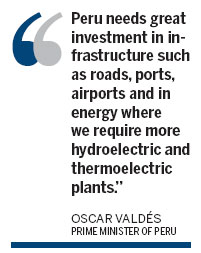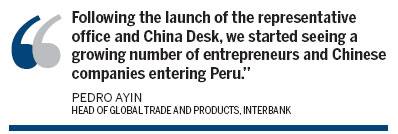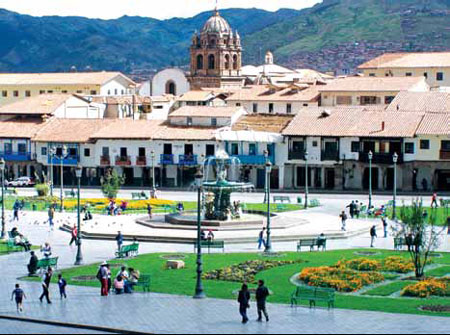Land of opportunity
Updated: 2012-05-24 08:12
(China Daily)
|
|||||||||||
|
Hidden high in the magnificent Peruvian Andes, the ancient city of Cuzco is a popular tourist destination. |
With the strongest economy in Latin America, Peru is the continent's investment hotspot
Centuries after the famous Inca civilization roamed its majestic mountains, lush jungle and attractive coast, the Republic of Peru is making history of a different kind through record foreign direct investment - including $3 billion from China - thanks to its booming economy and vast natural and human resources.
Rich in culture, history and potential, the ambitious country of 30 million people has made impressive socioeconomic progress over the past decade and transformed itself into a modern and business-friendly destination for investors from around the world.
With a strategic location on the west coast of Latin America, Peru is bordered by Ecuador and Colombia to the north, Chile to the south and Brazil and Bolivia to the east.
The bustling capital Lima, also known as the "City of Kings", is home to 12 million people and acts as the country's commercial, industrial and manufacturing hub. Other major cities include Arequipa, Trujillo, Chiclayo and Tacna.
However, Peru's most famous city, Cuzco, sits high in the stunning Andes and is a magnet for tourists as the gorgeous city is the gateway to the magnificent Inca ruins of Machu Picchu.
A few hundred miles to the west, and Lima's well-preserved historic center - declared an UNESCO World Heritage Site in 1988 - is the seat of government with Congress and key ministries located in the attractive area.
Elected last year, Peruvian President Ollanta Humala vowed to build on the steady socioeconomic progress made under his predecessor Alan Garca, with his approach reassuring foreign investors keen to take advantage of countless investment opportunities.
High-level talks
In a meeting with Chinese President Hu Jintao in Hawaii in November last year, President Humala recognized the vital role major trading partners like China play in Peru's future, and said he attaches great importance to developing relations with China and working with Beijing to promote the bilateral strategic partnership.
The pair recently celebrated the 40th anniversary of diplomatic ties and in 2009 signed a free trade agreement to enhance economic cooperation.
China is now the leading destination for Peruvian goods, importing nearly $7 billion of products in 2011, ahead of Switzerland and the United States.
That figure represented 15 percent of the Andean country's total exports last year, with exports rising 25 percent from previous year to nearly $48 billion.
Minerals, fish and agricultural goods comprised nearly three quarters of the country's total exports to countries including China. During the talks in Honolulu, the two heads of State exchanged views in a "candid and in-depth manner" as they looked to build on the solid platform created by a strategic partnership signed in 2008.

Four-point plan
According to President Hu, bilateral trade stands at $10 billion and the pair are making "substantial progress in trade and economic cooperation and closely coordinate with each other in regional and international affairs."
In order to build on these strong foundations, the Chinese leader suggested a four-point plan to improve bilateral ties even further.
The first was the continuation of high-level contact with regular exchanges of views on issues of common concern, while the second was pragmatic cooperation in areas like energy, mining, infrastructure, technology, finance, agriculture and environmental protection.
President Hu also called for the strengthening of cultural exchanges and international exchange programs for children and students, and urged both countries to work towards closer multilateral cooperation.
President Humala, who has visited China twice, said he is looking forward to working with President Hu on improving people's lives and reinforcing bilateral trade, diplomatic, political, commercial and cultural ties.
"Peru is willing to advance this win-win cooperation in the areas of trade, economy, energy, mining, infrastructure construction, environmental protection, technology and tourism," he said, adding he wants to see more cultural exchanges between the two countries and more consultation and coordination in other areas.
Blessed with a wealth of precious minerals such as gold, silver, copper, zinc, iron ore and lead, Peru's GDP jumped nearly 7 percent in 2011, with robust growth forecast for this year and next, supported by millions of dollars of FDI.
Given these substantial deposits, mining forms the backbone of the country's economic activities, ahead of agriculture, fisheries and tourism.
In a December 2011 report, the International Monetary Fund (IMF) said: "The Peruvian economy emerged largely unscathed from the 2008-09 global crisis supported by strong fundamentals and proactive macroeconomic response. The recovery was propped by significant macroeconomic policy stimuli, a quick turnaround of terms of trade and favorable external financial conditions, with renewed capital inflows."
Turning to the future, the report continued: "Against a background of heightened risks to the global outlook, policies should remain flexible. Peru's solid fundamentals and scope for policy response are likely to mitigate the effects of a weak world economy. Once international turbulence subsides, strong growth prospects in Peru and abundant international liquidity could increase capital inflows."
According to Prime Minister, Oscar Valds, Peru is the "land of opportunity" but that needs support from other countries to achieve its full potential. "Peru needs great investment in infrastructure such as roads, ports, airports, and in energy where we require more hydroelectric and thermoelectric plants," he said.
Officials are keen to attract investors to more rural parts of the country and are focused on "bringing jobs and investment to the poorest regions of the interior", he added. "To bring this investment we must interconnect the country better, make roads, bring energy, telephony, education," Valds stated. "It is the mission of this government to decentralize the country's industrial activity that is concentrated in Lima. We are encouraging investors to take factories out of Lima and settle there.
"We are working hard to strengthen ties between the two countries. In terms of export targets, we will gradually increase them. Ten years ago, Peru's exports were worth $10 billion, now we are at $48 billion and by 2016 we want to reach $86 billion. China is the key to meeting these goals."

Robust banking sector
Since the turn of the century, Peru's fast-growing economy has been one of Latin America's best performers, with the robust, profitable and well-capitalized financial sector providing a strong foundation for this success.
Backed by a strong regulatory framework, the banking and financial services industry has expanded in line with the huge flows of FDI and growing middle class that enjoys higher salaries and requires greater access to credit facilities like loans, credit cards and mortgages.
Peru has more than 60 financial institutions, of which about 15 are commercial banks, and the majority controlled by foreign owners.
Founded in 1897, Interbank has become a leading player in the Peruvian banking sector and is regarded as one of the country's top four financial institutions. In early 2007, the firm opened an office in Shanghai as part of its strategic development. Two years later it launched a trading company.
Interbank has remained one of the republic's most innovative retail and commercial banking institutions and seeks, above all, to promote businesses in the country. Through a partnership with Bank of China, the company established a "China Desk" that provides help and support to Chinese enterprises chasing business and investment interests in Peru.
Interbank ATMs accept cards issued by Chinese bankcard association Union Pay.
"Following the launch of the representative office and China Desk, we started seeing a growing number of entrepreneurs and Chinese companies entering Peru," said Pedro Ayin, head of Global Trade and Products.
"More Chinese businesses are arriving in Peru, mainly concentrated in mining, agro-industry, and infrastructure but some are in telecommunications. The FTA with China has greatly helped the commercial trade between the two countries. This is highly enhanced by the arrival of more Chinese investments and businesses. China is a great opportunity that had to be taken. Our customers say 'the best way to know China is to go to China'."
With nearly 2,000 miles of coastline, 200-mile maritime boundary and favorable weather conditions for fishing, Peru's fisheries sector is extensive and offers profitable returns for foreign investors given the high domestic and foreign demand for fish, seafood and fishmeal - used to feed animals.
One of the most important fishing companies in Peru, Corporacin Pesquera Inca (Copeinca) was founded in 1994 as a family-run business.
The firm now boasts a fleet of 28 vessels, five plants and 1,400 employees. The firm's key products include fishmeal - a source of protein obtained by cooking, pressing and drying raw fish, specifically anchoveta - and fish oil, which is produced during the fishmeal process.
Headquartered in Oslo, Norway, Copeinca is a major investor in research and development and committed to environmentally-friendly fishing methods, sustainable development and social responsibility.
"In our products, Peru and China are in charge: China as the main consumer and Peru as the main producer and exporter. Europe was our main market for a long time but stopped 10 years ago when China started to become relevant," said Copeinca CEO, Pablo Trapunsky.
"In 2010, we made an investment plan of $80 million that included new ships and the technological conversion of our plants. We intend to do something else with the products in order to give them more value, increase the turnover and hence, get something more than what we already have."
InFocus provided the story
(China Daily 05/24/2012 page6)
Hot Topics
Editor's Picks

|

|

|

|

|

|








